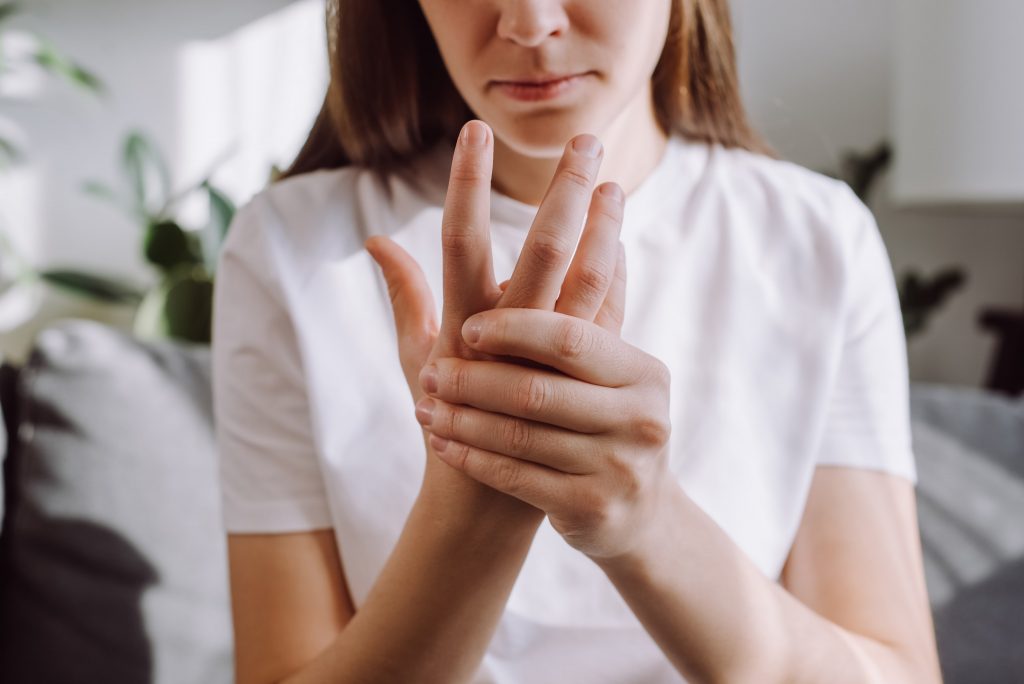Flexor tendonitis, also known as trigger finger, is a condition that primarily affects the tendons in your hands and wrists and can make even the simplest tasks feel challenging. It’s not limited to just these areas—it can also occur in other parts of the body where flexor tendons are present, such as the fingers, forearms, elbows, and even the feet. Whether it’s gripping a pen, typing on a keyboard, or holding a coffee cup, the pain and stiffness associated with this condition can disrupt daily life.

Causes of Flexor Tendonitis
Understanding the causes of flexor tendonitis is essential for effectively addressing and preventing the condition. Common contributing factors include:
- Repetitive Strain: Activities that involve frequent, repetitive movements of the fingers, such as typing, sewing, or playing specific musical instruments, can overwork the flexor tendons, leading to inflammation.
- Excessive Force: Sudden, forceful motions that strain the tendons, like those encountered in sports like rock climbing or football, can precipitate tendonitis.
- Underlying Conditions: Certain medical conditions, such as rheumatoid arthritis, diabetes, or gout, can predispose individuals to fluid accumulation around the tendons and joints, increasing the risk of tendonitis.
- Direct Trauma: Cuts, lacerations, or ruptures to the flexor tendons, often resulting from accidents or injuries, can trigger inflammation and impair their function.

Symptoms of Flexor Tendonitis
Recognizing the symptoms of flexor tendonitis is crucial for timely intervention and effective management. Common symptoms include:
- Pain and Tenderness: Discomfort during finger movements and tenderness when pressure is applied to the affected flexor tendons.
- Stiffness and Limited Mobility: Reduced flexibility and range of motion in the affected fingers, making it challenging to bend or straighten them fully.
- Clicking or Catching Sensations: Audible or tactile sensations of the tendons catching or clicking as they move through the inflamed sheaths.
- Swelling and Nodules: Visible swelling or the presence of nodules (bumps) along the length of the affected tendons.
- Weakness and Impaired Grip: Diminished strength and difficulty grasping or holding objects firmly due to compromised tendon function.
Diagnosing Flexor Tendonitis
Diagnosing flexor tendonitis typically begins with a thorough medical history and physical examination. During the examination, Dr. Peter Howard will assess the affected area for signs of tenderness, swelling, and pain. The provider may also ask you to perform specific movements or tasks to evaluate the range of motion and detect any limitations or discomfort. Imaging tests may be utilized to better understand the tendons’ condition. An ultrasound can provide real-time images of the tendons, helping to identify inflammation, fluid accumulation, or structural abnormalities. Magnetic resonance imaging (MRI) offers detailed cross-sectional images that can reveal deeper insights into the tendons’ condition, such as tears or significant changes in the tendon sheath. These diagnostic tools help confirm the presence of inflammation or structural changes in the tendons. Early and accurate diagnosis is crucial for developing an effective treatment plan and preventing further complications.
Treatment Options
Effective treatment for flexor tendonitis involves a combination of approaches aimed at reducing inflammation, relieving pain, and promoting healing. Common methods include:
- Rest and Activity Modification: Reducing or modifying activities that exacerbate the symptoms to allow the tendons to heal.
- Physical Therapy: Engaging in targeted exercises and stretches to strengthen the tendons and improve flexibility.
- Splinting: Using splints or braces to immobilize the affected area and reduce strain on the tendons.
- Corticosteroid Injections: Administering injections to relieve severe inflammation when other treatments are ineffective.
- Surgical Intervention: For persistent cases, more advanced treatments, such as surgical intervention, may be considered. Consulting with Dr. Howard to tailor the treatment plan to individual needs is essential for effective management and recovery.
Rehabilitation and Recovery
Rehabilitation and recovery from flexor tendonitis involve a multifaceted approach to restore function and alleviate pain. The process typically begins with rest and modification of activities that aggravate the condition, allowing the tendons time to heal. As symptoms improve, physical therapy becomes crucial, incorporating exercises to strengthen the tendons, improve flexibility, and restore range of motion. Splints or braces can help immobilize the affected area and prevent further strain. Pain management through medications and ice therapy can also support recovery. Gradual reintroduction of activities ensures that the tendons are not overstressed, promoting a more effective and sustained recovery.
Lifestyle Adjustments for Preventing Flexor Tendonitis
In addition to medical treatment and physical therapy, making certain lifestyle adjustments can help prevent the recurrence of flexor tendonitis and support overall tendon health. Consider these strategies:
- Ergonomic Modifications: Adjust your workspace and tools to reduce strain on your tendons. For example, use ergonomic keyboards and adjust chair heights and desk positions to maintain proper hand and wrist alignment.
- Regular Breaks: Take frequent breaks during repetitive tasks to reduce strain on your tendons. Stretch and rest your hands and wrists to prevent overuse.
- Proper Technique: Use proper techniques when engaging in repetitive movements or heavy lifting activities. Ensure your posture and hand positions are correct when typing or playing instruments.
- Strengthening Exercises: Incorporate exercises that strengthen the muscles around the tendons, enhancing their resilience and reducing the risk of future injuries.
- Healthy Lifestyle: Maintain a healthy diet and stay hydrated to support overall tendon health. Proper nutrition can aid in tendon repair and reduce inflammation.
By integrating these lifestyle adjustments into your daily routine, you can enhance tendon health, prevent the recurrence of flexor tendonitis, and support your long-term recovery.

Contact Dr. Howard for Treatment
Effectively managing flexor tendonitis requires a comprehensive approach that begins with a thorough diagnosis to identify the condition and its underlying causes accurately. Understanding the symptoms and undergoing appropriate imaging tests are crucial steps in developing a targeted treatment plan. You can alleviate discomfort and restore functionality by combining rest, physical therapy, pain management, and more advanced interventions. Early diagnosis and intervention not only aid in a quicker recovery but also help prevent future complications, ensuring a better quality of life. If you suspect you have flexor tendonitis, contact Dr. Peter Howard, M.D., today for expert guidance and personalized care to set you on the path to effective treatment and long-term relief.
